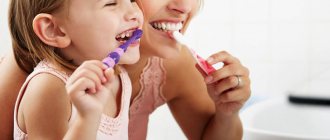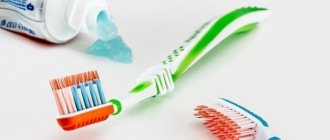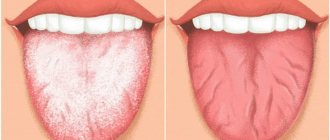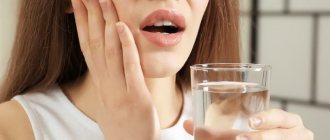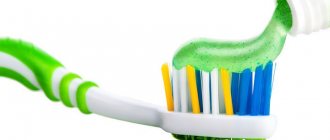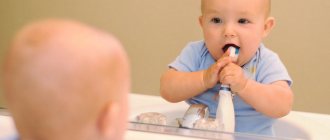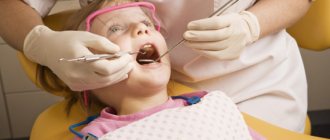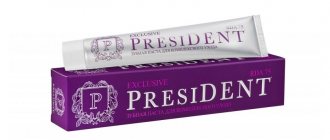Why brush your teeth?
You need to learn how to care for your mouth from early childhood. Of course, children 8–9 months old (the time the first tooth erupts) are not able to do this on their own. Parents should show their concern here.
Plaque on the surface of the enamel is an accumulation of large amounts of tiny food debris. If oral care is not taken on time, plaque increases. Combining with saliva, it mineralizes and becomes a stone that cannot be removed only with a brush. Important: the stone causes caries, periodontitis and other diseases. Caries is a trigger that essentially causes a chain reaction.
Caries and periodontitis
The structure of enamel is naturally porous and rough. Plaque on the surface fills the pores, causing inflammation. This is caries. If no measures are taken and prevention is not carried out, the disease spreads deeper. Over time, the inflammatory process spreads to the gums and roots.
Periodontium is the tissue surrounding the root of the tooth. It fixes it in the bone structure of the jaw. Inflammation in this area leads to the formation of a cyst.
Periodontitis
Destruction of the supporting apparatus of the tooth. At the same time, the gum gradually moves back and a pocket appears. This is where food debris accumulates. It is impossible to remove them yourself. Against this background, the gums swell, begin to bleed, and become sensitive during chewing. Purulent formations may appear in the pocket. Untimely treatment leads to loosening, displacement, and loss of teeth.
Important! Periodontitis is the second most common disease after caries. According to WHO, this pathology is diagnosed in 75% of children and 93% of adults.
Periodontal disease
According to statistics, out of 10 patients, periodontal disease is observed in 6 people. The disease is characterized by impaired blood supply to tissues. This leads to their degeneration and exposure of the neck of the tooth. The gums gradually rise above each other. At the same time, they do not turn red, do not swell, do not bleed, but simply slowly collapse.
Usually the disease affects both jaws at once.
Tooth loss
It needs to be prevented from early childhood. Parents do not always think about the consequences of premature tooth loss in their child. The thinking of some fathers and mothers is as follows: why treat caries of children’s teeth, because they are baby teeth and will soon fall out. This is a big misconception. By affecting baby teeth, caries leads to their premature loss.
Nature intended that the permanent tooth should replace the milk tooth, pushing it out. This order is a normal process. With premature loss, physiology is disrupted, which leads to improper eruption, crooked teeth and changes in bite. Such transformations entail many problems - impaired diction, deformation of facial features, gastrointestinal diseases. Adults experience the same problems when their teeth fall out.
Gastrointestinal diseases
Incorrect bite and lack of proper number of teeth affect the process of grinding food. Insufficiently chewed food ends up in the stomach, which finds it difficult to digest such food. As a result, gastric juice, which contains hydrochloric acid, is released abundantly. A large amount of it irritates the walls of the stomach. Over time, they become inflamed and gastritis develops. In case of untimely treatment, the pattern of disease development is probably known to everyone: gastritis - ulcer - oncology. And it is not a fact that the inflammatory process will not reach the duodenum or intestines.
Chronic pathologies
It would seem, what is a raid? A small buildup on the enamel surface that can be removed with a brush. But many pathogenic bacteria live in this area. If you do not clean the oral cavity, bacteria can migrate through the bloodstream (especially if the integrity of the gum tissue is damaged), move to the tonsils, and into the sinus area. This way the infection can reach any organ.
Think about the numbers! Out of 10 children with early caries, 9 suffer from chronic diseases of the respiratory and ENT organs! According to statistics, caries in childhood causes the development of a chronic form of sinusitis and tonsillitis.
A migrating infection can cause meningitis and provoke encephalitis. Diseases are difficult to treat, their consequences are terrible - dementia, disability.
In medical practice, there are known cases of death from sepsis. The cause is a bacterial infection that first caused tooth decay and then entered the bloodstream and caused sepsis. This advanced disease and its untimely treatment leads to death.
Psychological problems
In childhood, malocclusion becomes the result of crowded teeth, changes in facial features, and impaired diction. Often children feel awkward and begin to develop complexes. In the future, insecure people, already adults, cannot arrange their personal lives. In most cases, the lack of a smile is due to embarrassment and reluctance to talk again.
Psychologists say that in 15% of cases, alcoholism, drug addiction and teenage suicide are associated with complexes about appearance. 10% of them relate specifically to impaired diction and a deformed face due to malocclusion.a
So, caries caused by plaque can cause a lot of negative consequences. This can be avoided by maintaining oral hygiene and paying due attention to your health.
How often should you brush your teeth?
Dentists recommend caring for your oral cavity 2 times a day (morning and evening). But the hygiene procedure does not end there. To prevent the development of caries, it is necessary to rinse your mouth after every meal. It doesn’t matter whether a person ate an apple, cracked seeds, or had a full lunch.
Intensive rinsing removes harmful bacteria and stuck food pieces. It is, of course, advisable to use special foams or rinses. You can make a solution of salt and soda (1 tsp per 0.5 liter of water). But if this is not possible, then at least use a floss and rinse your mouth with water.
How to choose a toothbrush
Not only is the correct cleaning technique important, but also the brush. When choosing a product, you need to navigate their diversity:
- Very soft brushes designed for children. This type is chosen for children over 5 years old, as well as people diagnosed with periodontitis. It is recommended that children under 2 years old brush their teeth with special silicone fingertips.
- Medium bristles hardness. Recommended for teenagers over 12 years old.
- Hard brushes. Can only be used after consulting a doctor. Excessive hardness causes enamel destruction. Recommended for coffee lovers, smokers, and people with increased stone formation. But such brushes can only be used by those who have strong enamel and a healthy oral cavity.
- Very hard brush. We are talking about brushes used in cases where bridges and braces are installed.
- Electric brushes. According to dentists, they are best for removing soft deposits. In addition, there is no need to make additional movements during cleaning. It is enough to slowly move the device over the surface of the teeth, and the electric brush will do the rest itself. But if the gum tissue is weak, then such a procedure can cause injury.
- Ultrasonic brushes. Does not damage gums. Approved for use for diseases of the oral cavity, installed braces or implants. Ultrasound cleans exposed surfaces and removes bacteria at a depth of 5 mm under the gums.
- Working head size. Preference should be given to products with small working heads. In this way, soft tissue injury can be prevented.
Pay attention to the hardness level markings. Responsible manufacturers always indicate it on the packaging:
- sensitive – very soft brushes;
- soft – soft;
- medium – brushes with medium hardness;
- hard – very hard;
- extra-hard – special brushes that remove large amounts of plaque and are intended for people with installed restoration structures.
An important rule: you need to change the brush every 3 months.
Advantages of the device
Electric toothbrushes have many benefits:
- This device provides a whole range of possibilities for cleaning, massage and care of the oral cavity.
- Moving bristles and several operating modes facilitate and speed up the cleaning process, and also allow you to thoroughly clean interdental spaces and hard-to-reach places, such as “sevens” and “eights.”
- Electric brushes make it much easier to care for orthodontic braces.
- Electric brushes deal with stains from tea or coffee 21% better than a regular manual brush, and with gingivitis - about 11%.
- Using an electric brush prevents the possibility of injury to the gums or destruction of enamel. Provided proper operation and the correct choice of attachments, cleaning with this device is less traumatic.
- Children love brushing their teeth with a children's electric toothbrush. This makes the boring morning ritual interesting for them and they perform it with more enthusiasm.
Important! If you decide to purchase an electric toothbrush, then don’t skimp. Remember, a high-quality device cannot be cheap. The price of branded models starts from 7 thousand rubles. By choosing a cheaper device, you risk buying a fake, which can quickly break down, or, even worse, harm your health.
Choosing a toothpaste
Almost all pastes are therapeutic and prophylactic. Serve for mechanical cleansing and help prevent caries, periodontitis, and periodontal disease. To do this, the composition includes various components that should be taken into account when choosing a care product:
- Fluorides and calcium. Included in the composition for the prevention of caries and restoration of enamel structure.
- Medicinal plants, essential oils, antiseptic substances (chlorhexidine, triclosan). Eliminate bleeding, swelling of the gums, remove plaque.
- Potassium, strontium, aminofluoride, hydroxyapatite. Reduce tissue sensitivity and relieve pain.
- Enzymes (papain) and antimicrobial substances (lysozyme, lactoferrin, lactoperoxidase). Added to whitening pastes to increase the effectiveness of plaque removal.
- Vitamin complex (A, E, C, B, carotoline). Improves metabolic processes, accelerates the healing of the mucous membrane.
You need to choose a paste depending on your existing dental problems. Don't get carried away with fluoride-containing toothpastes. If there is an excess of fluoride, fluorosis can develop. Therefore, fluoride-containing toothpastes are used no more than once a day.
Clinical researches
Clinical studies have proven that regular use of professional toothpaste ASEPTA REMINERALIZATION improved the condition of the enamel by 64% and reduced tooth sensitivity by 66% after just 4 weeks.
Sources:
- Report on the determination/confirmation of the preventive properties of personal oral hygiene products “ASEPTA PLUS” Remineralization doctor-researcher A.A. Leontyev, head Department of Preventive Dentistry, Doctor of Medical Sciences, Professor S.B. Ulitovsky First St. Petersburg State Medical University named after. acad. I.P. Pavlova, Department of Preventive Dentistry
- Evaluation of the clinical effectiveness of a combined drug of local etiotropic action in the treatment of inflammatory periodontal diseases (E.L. Kalichkina, E.A. Tyo, Z.Z. Abubakarova) E.L. Kalichkina, candidate of medical sciences, assistant of the department of therapeutic dentistry, Kemerovo State Medical Academy of Roszdrav, Kemerovo E.A. Tyo, MD, professor, head of the department of therapeutic dentistry, Kemerovo State Medical Academy of Roszdrav, Kemerovo Abubakarova, assistant of the department of therapeutic dentistry, Kemerovo State Medical Academy of Roszdrav, Kemerovo GOU HPE Kemerovo State Medical Academy of Roszdrav , Kemerovo
- Clinical and laboratory assessment of the influence of domestic therapeutic and prophylactic toothpaste based on plant extracts on the condition of the oral cavity in patients with simple marginal gingivitis. Doctor of Medical Sciences, Professor Elovikova T.M.1, Candidate of Chemical Sciences, Associate Professor Ermishina E.Yu. 2, Doctor of Technical Sciences Associate Professor Belokonova N.A. 2 Department of Therapeutic Dentistry USMU1, Department of General Chemistry USMU2
Step-by-step instruction
Cleansing takes 3 minutes! Particular attention should be paid to hard-to-reach areas: gum line, interdental spaces.
Cleaning scheme:
- Wet the brush with warm water.
- Apply the paste in a thin strip to the brush.
- Start cleansing from the upper jaw. First, treat the outer molars and chewing teeth behind the cheeks.
- The direction of movement is from left to right. If you are left-handed, it is better to start on the right.
- The basic rule of the technique is to place the brush parallel to the gums.
- Do not press too hard on the brush.
- Movements are circular, brush each area for 10 seconds. During this time, make 10 movements with the brush.
- Then start brushing from the gums to the bottom edges.
- Next, treat the inner surfaces in the same way.
- Clean your tongue and inner cheeks.
- Rinse your mouth, changing the water 3 times.
Don’t forget to wash your brush and treat it with an antiseptic after each procedure.
Teaching correct methods to children
Cleaning children's teeth often causes a lot of problems. Before starting this activity, the child needs to be interested or motivated . As a rule, imagining the cleaning process in the form of a game gives a good effect.
But even if the child is happy to do this procedure, it is worth monitoring the correct execution of all actions. How should children brush their teeth?
This question can only be answered by conditionally dividing them into two groups:
- Children under one year old .
This category of children, just like adults, needs to clean their emerging teeth. Already from the appearance of the first teeth, it is worthwhile to regularly clean them. To do this, after each feeding, wipe the surface of the teeth with a clean napkin or cotton pad moistened with boiled water. - Children after one year .
For this category, this procedure does not differ from the standard process of brushing teeth for adults. The only difference is the paste and brush used: up to three years, the brush must be soft and not cover more than two crowns, and the paste cannot contain fluoride. After this age, when using such products, you must adhere to the dentist’s recommendations.
The entire cleansing process should be carried out under the supervision of an adult and not exceed 3 minutes, since the enamel in children is too weak.
Proper brushing of teeth is considered an insignificant process. But practice shows that compliance with the necessary technique is an important factor in preventing dental diseases.
Well, the following video will help teach your child how to brush their teeth correctly:
If you find an error, please select a piece of text and press Ctrl+Enter.
Tags braces video dental floss toothbrushes irrigators monobeam toothbrushes ultrasonic toothbrushes teeth cleaning electric toothbrushes
Did you like the article? stay tuned
Toothpicks and chewing gum
Dentists do not recommend using toothpicks at all. The wood from which they are made flakes when cleaned. The separated particles can remain between the teeth and, over time, begin to rot and cause inflammation. And also, while using a toothpick, you can injure your gums without even noticing it. Alternatively, use thread.
It is a mistaken belief that chewing gum will help get rid of plaque and stuck pieces of food. Yes, undoubtedly, some parts of the remaining food will stick to the gum. But during the chewing process, when the gums press against each other, these same particles can get stuck in the interdental space.
In addition, recently placed fillings that have not withstood prolonged exposure “like” to stick to chewing gum.
Chewing gum does not strengthen the gums; this happens in the process of uniform chewing, and not when squeezing the jaws in one place. Chewing gum is usually one-sided and can lead to muscle atrophy on the opposite side because it will not receive the stress it needs.
Another disadvantage is that constant chewing will lead to overload of the periodontium. Against this background, periodontitis and gingivitis can develop.
Chewing gum contains dyes and sweeteners. Do not forget that dye E131 (contained, for example, in Stimorol chewing gum) causes the formation of cancer cells, E171 – liver and kidney diseases.
To remove food debris after eating, it is better to rinse your mouth with water 2-3 times or use a mouthwash or foam.
How to properly brush teeth with braces
With braces installed, teeth must be brushed 3 times a day. Regardless of whether you have removable braces or not, cleaning should first be done in the standard way using a brush and paste.
A prerequisite for braces and veneers is the use of an irrigator. This device uses a thin stream of liquid under high pressure to efficiently clean the enamel, gum pockets and the space between the teeth from fresh and old plaque.
How long should brushing your teeth take and why?
It is impossible to say for sure how many minutes you need to brush your teeth in order for them to remain healthy for a long time.
Normally, teeth should be brushed for 2–3 minutes, but the exact period depends on:
- number of dental units;
- general condition of the oral cavity;
- the presence of orthodontic structures.
It is not recommended to clean the enamel for too long, since prolonged mechanical impact can cause injury. For this same reason, people who eat a lot of raw fruits and vegetables often need restorative mineralization.
How to properly brush your teeth with an electric brush?
The electric brush can make up to 25 thousand rotations per minute. Therefore, the cleansing procedure takes less time.
There are more powerful brushes, for example, from. They make up to 45 thousand rotations per minute.
The usage scheme is, in principle, standard. You don't need to strain or make any movements. She works on her own. The brush should be held parallel to the teeth, without pressing, and moved along the surface.
The procedure time is 1.5–2 minutes.
Dr. Zubastik recommends
After each procedure, rinse the brush. Do not store children's and adult teeth-cleaning devices in the same place - the infection can easily spread to neighboring hygiene products.
Interesting! Ancient people ate food given by nature itself, receiving a large amount of vitamins and a massage effect for the gums. They lived to old age, keeping all their teeth in excellent condition. Our ancestors ate rough, solid food and fruits without using a knife. According to anthropological researchers, ancient man did not know caries. The lack of teeth could only be a consequence of surviving and fighting the beast.
Tags: braces, toothbrush, toothpicks, teeth cleaning
About the author: Dr. Zubastik
Typically, a toothache begins to subside on the way to the clinic and finally goes away after 10 minutes of sitting in line to see the dentist.
- Related Posts
- Sponges for cleaning teeth: how to use?
- 5 home care products for braces
- How to get rid of tartar at home: folk remedies, brushes and pastes
« Previous entry
Contraindications for use
In addition to the benefits and pleasure of use, electric brushes also have a number of contraindications and disadvantages :
- Before you start using the device, it is advisable to obtain the approval of your dentist, who will evaluate the condition of your teeth. You will also receive the necessary advice and recommendations.
- Those people who have sore or weak gums are not recommended to use an electric toothbrush every day. You can alternate it with a manual analogue and monitor your well-being.
- Thin, sensitive enamel can also be damaged by thorough cleansing with an electric brush.
- The use of an electric toothbrush is contraindicated for people with serious heart disease.
- The main disadvantage of the device is the high cost of the device itself and the attachments, which must be changed regularly.


